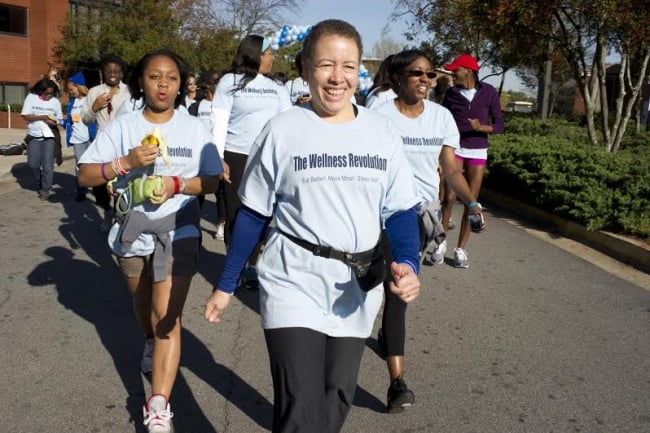You have /5 articles left.
Sign up for a free account or log in.

Beverly Tatum, Spelman's president, walks with students during the annual Wellness Revolution 5K race.
Spelman College
It has been nearly two years since Spelman College announced that it was withdrawing from the National Collegiate Athletic Association and ceasing its participation in intercollegiate sports. It was a surprising move, even for a historically black women's college with a small sports program. Spelman was one of only two colleges to withdraw from the NCAA that decade, and it did so at a time when many college athletic programs were clamoring for a bigger piece of the college sports pie.
When that appetite led three colleges to leave the Great South Athletic Conference and effectively disband the league in 2011, Spelman was left without a conference. So Beverly Daniel Tatum, the college's president, opted not to join another league, redirecting the college's $900,000 athletics budget to a campuswide student health initiative.
Spelman calls the initiative "a wellness revolution," and -- more than a year after the tennis team played its final match -- the revolution is finding its legs, Tatum said. In 2012, the number of students enrolled in fitness classes at the college's wellness center was 278. That number is now more than 1,300. Spelman's undergraduate enrollment is about 2,100 students.
"One of the things colleges try to create with students are these habits of the mind," Tatum said. "But it's also a wonderful time to develop what I call habits of the body. Students are making this investment in their education, and as educators we are investing in them. We want them to live long enough to see a return on that investment. The vast majority of students and alumni have embraced the idea."
That wasn't always the case. When Tatum announced that Spelman would no longer offer intercollegiate athletics, the news came as an unwelcome surprise to the roughly 80 athletes on campus. But since the change was announced a year in advance, about half of those students were able to graduate unaffected by the decision. Of the 40 athletes who remained, Tatum said, none transferred, though they were certainly disgruntled.
Mary Pickard, president of the Spelman Student Government Association, said students warmed up to the idea once they realized the hole left by athletics was meant to be filled with a focus on personal health.
"I think some students were disappointed or sad when we got rid of the athletic department, but gradually there was an understanding as to why it happened," Pickard said. "When the Wellness Revolution was announced in its place, students started to appreciate the decision even more."
Naturally, there were some fires to put out in the athletic department, too. Spelman's volleyball and basketball coaches left to take jobs elsewhere. Read Hall, the gym where the Spelman Jaguars competed for more than 60 years, is gone as well. Built when Spelman's enrollment barely topped 500 students, it was too small to house the campuswide wellness initiative.
The college raised $18 million to build a new gym where Read Hall once stood, but with construction not expected to be complete until next fall, the number of fitness courses the college can offer is limited. When complete, the new facility will include a regulation-size -- but multipurpose -- basketball court, a swimming pool, dedicated spaces for spin classes and free weights, and a demonstration kitchen for teaching students how to prepare healthy meals.
In the meantime, Tatum said, the college has had "to get creative with space." A meeting room is now a temporary fitness center. Students learn yoga surrounded by sculptures and paintings in the Spelman Museum of Fine Art. "We're living without a building right now," Tatum said. "We'll offer more courses when the new building is ready. Swimming lessons will resume. Students will be able to join intramural basketball and volleyball teams. There will be more space for yoga, Zumba, and Pilates. It will be lovely."
Spelman now offers nearly 30 wellness classes a week, including Brazillian dance, hip hop aerobics, and piloxing -- a mix of boxing and Pilates. Seeking to appeal to students for whom fitness alone might not be enough of a draw, the college offers classes called Sweaty Sexy Samba, Black Girls RUN, and R.I.P.P.E.D, as well as less creatively named cardio, kickboxing, and weight-training classes. Administrators pass out water bottles and challenge students to drink two to three bottles of water a day. The college occasionally hosts sports bra and shoe clinics to help students pick the correct athletic attire. Options at the campus dining hall now include tofu, humus, and other vegetarian choices. The pizza sold there is made with whole-wheat dough.
Brenda Dalton, Spelman's director of student health services and wellness, said getting students to think about more than just exercise has been a challenge.
"I believe students supported the idea of a wellness revolution in theory but may not have done as much with fitness or eating better or even getting right amounts of sleep," Dalton said. "I believe students are now all on board."
Students do seem to be getting the message, Pickard said.
"You really do see a change on campus," she said. "We challenge each other to drink more water and less pop. To get to bed before midnight. Students are more eager to work out. When you're looking for something to do after class, it's not uncommon to say, 'Let's all go to yoga tonight,' or 'Let's go to kickboxing,' or even just 'Let's go take a walk around the school.' That didn't really used to happen."
In 2013, the college partnered with the National Institute for Child Health and Human Development to host a wellness summit. The conference focused on nutrition, exercise, and sleep health -- the same tenets that form the core of Spelman's "Wellness Revolution." A second seminar is planned for February. In April, the third annual Wellness Revolution 5K Run will take place, and the college provides training workshops for students throughout the year leading up to the race. More than 700 students and faculty participate in the race each year, Tatum said, noting that it's the first time many Spelman students have ever participated in anything like a 5K.
And Tatum said that continues to be the main driver behind all of this. Forty-four percent of black women over the age of 20 have high blood pressure, according to the Centers for Disease Control and Prevention, and black women are more than twice as likely as white women to develop Type 2 diabetes. Black women are more likely to suffer and die early from heart disease, breast cancer, and strokes.
"Women are passing away in their 30s and 40s from illnesses that might have been prevented had they been more intentional about maintaining healthy fitness habits," Tatum said. "I have been to far too many funerals for relatively young alumnae."




